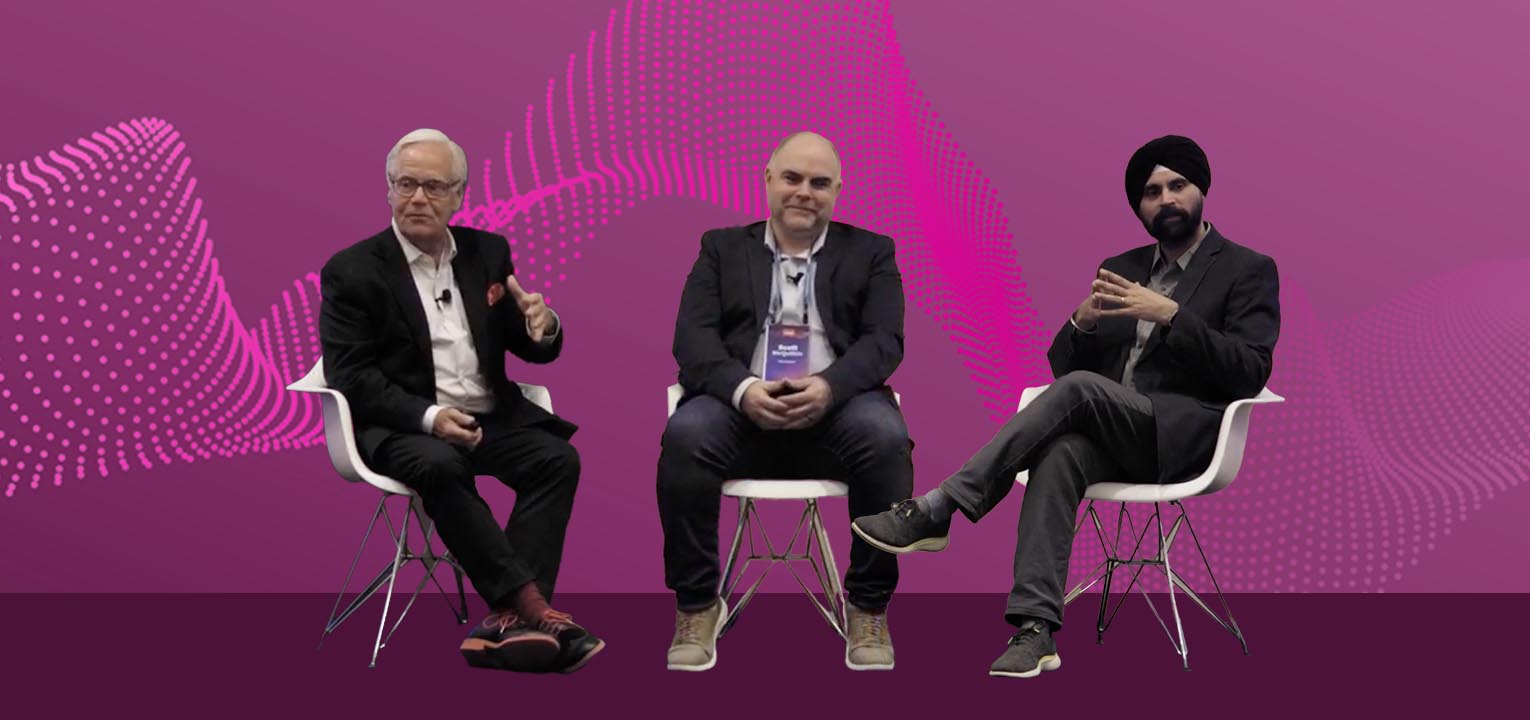December 21, 2023
The Changing Face of Banking: Top 7 Banking Trends for 2024

Top Banking Trends for 2024
In light of the prevailing economic uncertainty, geo-political instability and regulation creep, banking industry executives and leaders can hardly be faulted for having a less than sanguine outlook for 2024. There appears to be much more optimism for 2025. But alas, we will need to hold on to those predictions for another year. As Yogi Berra once said, it’s hard to make predictions, especially about the future!
One prediction I can make with some confidence, however, is that we will see greater separation between leaders and laggards in the banking industry. This separation is in part driven by greater “money in motion” as interest rate movements and technology advancements increase motivation for customers to select the best provider and move money accordingly.
While most of the industry will seek to drive operational efficiencies and cost reductions in 2024, progressive banks are opportunistically increasing investments in key capabilities that may create advantage in an environment with more money in motion. They recognize that challenging conditions allow strong performers to build or extend advantage, and win market share from those that choose to simply hunker down.
With all that in mind, let’s look into my turbid crystal ball to identify the top 7 trends that will shape the banking investment landscape in 2024.
Three macro trends influencing banking economics:
1. Bank transformation efforts come under pressure to deliver results
Many banks are undertaking one of four major transformation efforts: data transformation, core transformation, digital transformation, or merger transformation. In some cases, these resource intensive efforts are planned as multi-year investments to develop essential capabilities for competition. Consequently, near term business unit specific initiatives are put on hold. With growing cost concerns, these transformations will face pressure not just to prepare for the future but to produce concrete, short-term benefits to sustain ongoing investment. Banks will need to be more rigorous in identifying specific use cases that deliver business impact along the way and rescope transformation phases for quicker delivery or combine them with operational improvements.
Take data transformation programs as a prime example. Instead of envisioning a modernized data environment with clean, accessible data in two years, banks can prioritize data assets according to essential use cases. Tailor the transformation program to deliver near-term business benefits leveraging the prioritized data, and gain useful learnings for subsequent phases.
PNC is a prime example of a bank striking an effective balance between operational efficiencies and critical investments to compete. In its Q3 earnings report, PNC announced it was on track to deliver $400 million in savings in 2024 from its Continuous Improvement Program. In parallel, the bank is proceeding with a digital transformation to deliver the right mix of digital tools and experiences with more personalized human interaction and expertise that its customers seek.
2. The Battle for Deposits Intensifies
The competition for core deposits continues to heat up and is at the forefront of most leadership teams’ priorities. With the rise in the cost of funding, deposit outflows, and margin compression, every financial institution is vying for a better way to win, grow, and retain deposits from their customers. Simply executing from the traditional playbook of years past—incentivizing customers with promotional rates only—is insufficient to prevail in today’s competitive environment.
A 2023 McKinsey Panorama study showed that of six primary customer segments, two of them – “young/high income” and “middle age/high income” – hold greater than 60% of potential deposits in motion. The “young/high income” segment is at the highest risk of switching, with a switching rate of more than 3 times that of “middle age/high income.” The analysis goes on to conclude that banks that understand and cater to the unique needs of each customer/segment are likely to attract more deposits versus peers. Personetics’ own studies show that 58% of customers are open to switching to banks that have better money management capabilities based on individual customer needs.
While price and rate remain important, I believe the battle for deposits should be looked at through a different lens – one of customer engagement. This entails delivering tailored solutions/experiences based on customer behavior. Tailored experiences and product innovation will be the key factors in winning the battle for deposits.
Ally Bank, with its “Savings Boosters” (Savings Envelopes and Surprise Savings), is a prime showcase of this customer-first ethos with tailored experiences. Ally shared that more than 600,000 customers are using Savings Boosters and those customers are twice as likely to have multiple Ally products. One year after BMO launched Savings Amplifier, the goals-based savings solution is proving to be highly effective in driving customer engagement and satisfaction, and provided valuable intelligence on customers’ explicitly stated goals.
3. Applied AI at Scale
Beyond the hype of generative AI, the real winner in this renewed interest will be plain old “proven AI.” Make no mistake: GenAI WILL transform banking (Accenture predicts that 40% of all working hours can be impacted by LLM), but not in 2024. Bank model validation processes that demand algorithm transparency and controls will limit the scope of generative AI applications (i.e. emphasis on non-customer facing processes) until they can be validated and back-tested for impact and bias, and robust control points and processes are in place.
Applied AI, however, will flourish in 2024, finding broader applications in banking. Bank leadership teams and boards are challenging their teams to use AI to deliver value in 2024, rather than waiting for Generative AI to deliver on emerging use cases. AI algorithms trained on banking data and specific use cases will drive improvements in operational efficiency, risk management, and customer engagement. Most importantly, applied AI can deliver scalable results while maintaining control processes.
One such use case is customer engagement, which plays a pivotal role in customer loyalty and bank profitability. Many progressive banks are turning to applied AI to analyze customer transaction data to understand behaviors and anticipate customer needs in real-time. For example, U.S. Bank delivers tens of millions of insights monthly to customers, and RBC has introduced their NOMI experience to demonstrate they are looking out for customers.
As banks aim to differentiate, four key capabilities will drive more personalized engagement.
Four trends related to operational capabilities and areas of investment:
4. Virtual Assistants raise their IQ
Most people in the industry have heard about the remarkable achievements of Bank of America’s personal assistant, Erica. It handles more than 1.5 million customer interactions per day, and more than 98% of customers get the answers they need using Erica. Building on the success of the solution, Bank of America has made Erica smarter by enabling it to deliver proactive insights. Customers have viewed 37 million proactive insights to help review finances or cut monthly subscription costs.
Not to be upstaged, Wells Fargo has its own virtual assistant, Fargo. Wells says that Fargo “will take a more proactive role in guiding customers toward financial wellness by leveraging predictive analytics to enable meaningful conversations that learn and adapt to each individual customer.”
How quickly will banks transition from reactive virtual agents to intelligent predictive assistants? In 2024, banks will move beyond delivering generic alerts and notifications and toward more tailored engagement based on predicted financial behavior. Instead of simply alerting you once you have a low balance, your bank will anticipate a low balance – and other important financial nudges – and give you proactive suggestions to take relevant actions. Herein lies the next step-function gain with virtual assistants for banks.
5. Customer Journeys take center stage
Customers have a multitude of “jobs to be done,” such as saving for goals, cutting expenses, or improving credit scores. These objectives vary throughout a customer’s life. These goals can’t be achieved through just one action; banks need to help customers reach their desired outcomes over time. Banks are already using digital tools to engage customers and facilitate expressing and tracking their goals. For example, Wells Fargo’s Life Sync provides customers with visibility into their goals and their progress toward achieving them.
In 2024, banks will become more effective at identifying priority customer journeys, and provide a mix of tools, products, and trackers to help customers accomplish them. Rather than simply promoting standard, off-the-shelf products, banks will make it easier for customers to capture their goals, and tailor solutions to accelerate their progress towards them.
This, of course, will be done in phases focusing on the highest priority journeys that banks identify. The key is taking a cross-channel, cross-product approach to address the customer journey. A valuable by-product for banks is that customers who engage in these journeys will have much higher satisfaction and form deeper relationships with the bank.
6. Personalized Engagement Marketing is Born
The marketing banner is dead. Well, not quite yet, but the days are numbered for the generic, banal bank marketing banner. As it is, even targeted marketing banners on the authenticated site convert at around 1%. In many cases, customers simply tune out to bank marketing banner ads, even if there is sophisticated behind-the-scenes targeting occurring. Customers feel banks are simply trying to push their products, so it’s no surprise that marketing banners have weak conversion. The only real justification for them is that they can be done at high volumes and thereby achieve certain hurdles.
In 2024, we will see the birth of a new marketing concept: Personalized Engagement Marketing. Banks will use their knowledge of customer transaction data and behaviors to deliver personalized offers with evidence of how much customers personally benefit based on transaction patterns. This is a powerful concept and will fundamentally shift the customer engagement model between banks and customers.
7. Open Banking Gets its Growth Spurt
The CFPB recently released its much-awaited “Personal Financial Digital Rights” rule (1033). It promises to reshape how consumer financial data is accessed and used, ushering in a new era of bank-client engagement and competition. The rule requires financial institutions to provide consumers and authorized third parties access to data related consumers’ transactions and accounts. Progressive banks will embrace the rule not as a point of achieving “compliance,” but rather one of creating “advantage” for their customers.
2024 will be a year of preparation for accelerated Open Banking, with banks investing in both the mechanics of data access as well as capabilities to deliver improved experiences leveraging customer data. Banks will selectively embrace a partnership ecosystem that will help them deliver more personalized experiences on the most critical journeys defined by the bank.
Top Banking Trends 2024 – The Path Ahead
These top 7 trends banking trends for 2024 will contribute to a highly dynamic environment for the industry in 2024. With the high degree of economic uncertainty, banks will need to be deliberate on where they invest on key capabilities that help them amplify their product offerings and deliver on their points of differentiation. In the midst of uncertainty, there is one indubitable truth – hunkering down and simply cutting costs is not a viable option.
The leaders will prepare themselves to take advantage of trends in the economy, technology, and regulations. They will build capabilities not simply to achieve parity, but to enhance their distinctive offerings. The competitive bar will be raised in 2024, and progressive banks will build and retain stronger customer franchises as a result.
Want To See How Cognitive Banking and AI Can Transform Customer Engagement?
Request a Demo Now
Latest Posts

Truist's Performance Marketing Journey: From Merger Challenges to Million-Dollar Results

How Asia Pacific Banks Are Redefining AI-Driven Engagement

How iBank and Personetics are Transforming Personal Finance in Japan

Beyond Transactions: How Synovus is Creating Deeper Digital Engagement at Scale

4.5 Stars and 20% CTR: How BGL BNP Paribas’s Genius is Reinventing Digital Banking

The AI Implementation Reality Check

Jody Bhagat
President of Americas, Personetics
Jody brings deep operating experience in financial services – managing direct channels, launching digital ventures, and leading digital transformation programs. He was previously a Partner at McKinsey & Company, where he helped financial institutions define and execute digital transformation programs to drive customer growth and operating efficiency.
Jody also served in senior digital operating roles at U.S. Bank, Wells Fargo, and Providian. In these positions, he led digital sales and service functions and direct to consumer businesses to deliver organic growth and enhanced customer experience. Jody has an MBA from Northwestern University and a BS in Computer Engineering from The University of Michigan.









